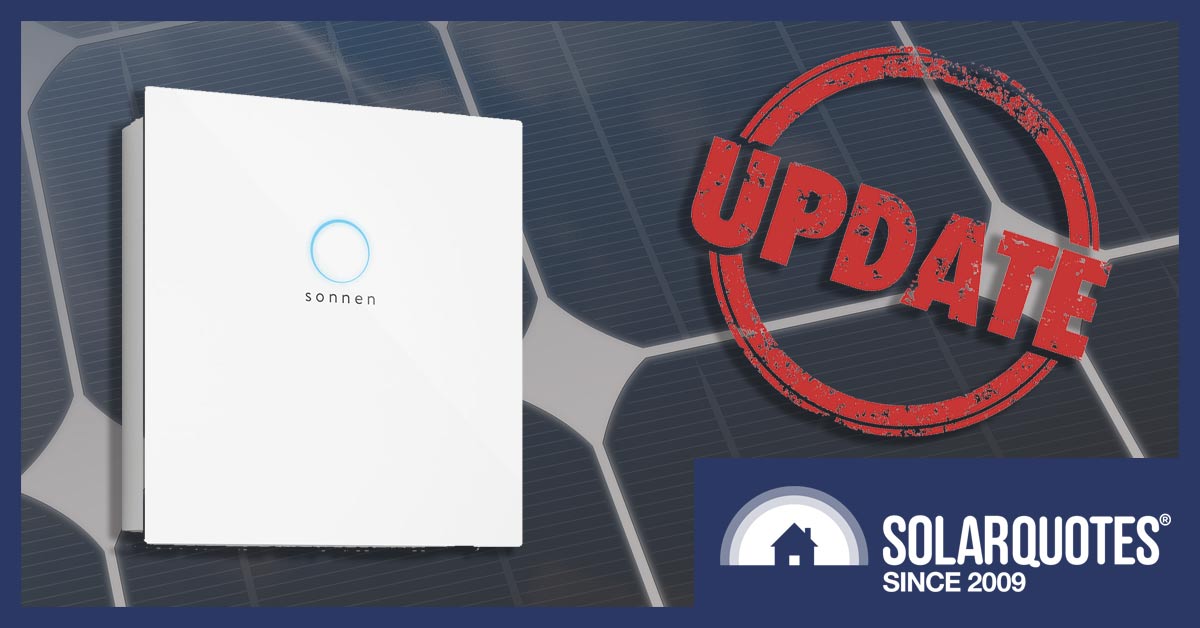
Sonnen updates their battery systems: outdoor enclosure, backup option and lower pricing now available.
Sonnen claim to be the first company to successfully market on-grid home battery systems. Founded in Germany in 2010, they have sold systems to Australians for two years now. Their 9th generation of home batteries — known as the sonnenBatterie Eco 9.43 — have been on sale in Oz since the 16th of August.
Sonnen’s a pretty big deal where I live here in Adelaide as they are planning to open an assembly plant that will employ an unbelievable number of people1.
Sonnen’s battery systems are AC coupled so they are compatible with any existing solar inverter. Features of their latest technology include:
- Five different sizes with nominal capacities from 5 to 15 kilowatt-hours. Usable capacity is 90% of this amount and ranges from 4.5 to 13.5 kilowatt-hours.
- Power output is 2.5 kilowatts for the smallest system and 3.3 kilowatts for the rest.
- Backup power during a grid failure is now available by installing a sonnenBackup-Box which gives up to 1.8 kilowatts of backup power
- The Sonnen battery is for indoor use but there is now an optional, large2 metal enclosure to allow outdoor installation.
- It operates at an air temperature of up to 45 degrees which is fine for most Australian homes. But for even higher temperature operation there is a small air conditioner unit that attaches to the metal outdoor enclosure.
I want to give you as much useful information as I can in this article on Sonnen’s latest batteries for two reasons:
- South Australia’s hefty battery subsidy should start on the 18th of October and Sonnen’s battery systems are the only ones I know of that can get the subsidy during its first 9 weeks.
- At time of writing, information on their latest battery systems is not available on Sonnen’s Australian website.
At the moment a Sonnen battery won’t save a normal household money, even with the South Australian subsidy, unless it lasts beyond its 10 year warranty period. But prices of battery systems are rapidly falling so it’s hopefully not too long before it can pay for itself within 10 years — at least for South Australians.
Sonnen & South Australia’s Battery Subsidy
South Australia is introducing a hefty battery subsidy that’s likely to start on the 18th of October. For most households this will give a subsidy of $500 for each kilowatt-hour of battery capacity, but pensioners and most who receive Centrelink payments get $600 per kilowatt-hour. The maximum subsidy per system is $6,000.
For the first 9 weeks the subsidy applies to only a limited number of batteries. Just what the criteria are for a battery join this exclusive group have not been made public. Apparently only those that make the sweetest love to the state’s economy are allowed. At the moment Sonnen is the only system I know that has made the cut. It remains to be seen if any other battery systems can make it, but it will be hard to top a battery assembly plant. I happen to know all you need to do is whisper the words, “light manufacturing” in a state government’s ear and they go all weak at the knees.
Nomenclature: A sonnen Battery By Any Other Name Would Charge As Sweet…
The full name of Sonnen’s 9th generation battery is sonnenBatterie eco 9.43 followed by a slash and a number to indicate its nominal battery capacity. But I’m not going to call it that. Firstly it’s a bit of a mouthful and secondly “sonnenBatterie” looks weird in English. It’s like they couldn’t afford a capital letter for the start of the word but still had enough money to pay for a capital B in the middle. What’s worse is the company isn’t even called Sonnen. It’s actually sonnen with a small “s” at the front. I told Germany to stop capitalizing every noun in their sentences otherwise they’d run out, but obviously they didn’t listen. Clearly their unhealthy Vanilla Ice addiction has deafened them.
Maybe in Germany it makes sense not to capitalize the word “sonnen”, which basically means “to sunbathe”. But since we are not in Germany and Australia is a rich and generous nation that is 22 times Germany’s size and has at least 22 times as many capital letters, I’m going to give them a free capital S every time I write the word Sonnen.
Sonnen’s Battery Chemistry
Sonnen’s make their 2.5 kWh battery packs in China. Sonnen procures them from two different sources so they can keep making their systems if one battery factory’s production is disrupted by a fire, a meteorite strike, or a giant radioactive Winnie the Pooh.
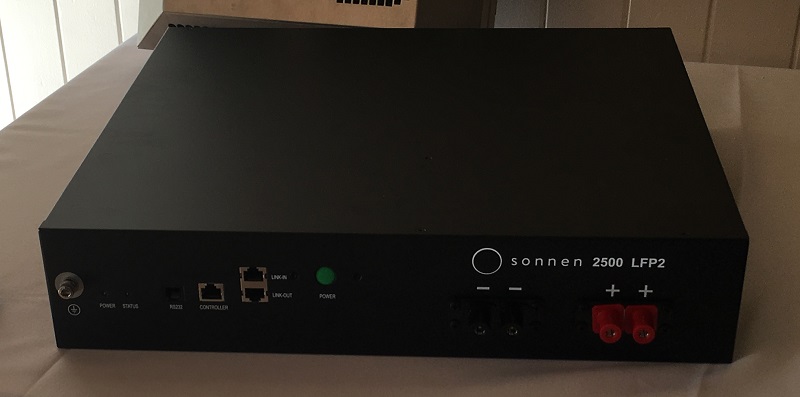
A Chinese made 2.5 kilowatt-hour battery module used by Sonnen. (Image Credit: Me)
The battery chemistry is lithium iron phosphate, which is the most rugged type of lithium battery and has a high cycle life. It is also the safest lithium battery chemistry and extremely unlikely to burst into flame. While any lithium battery system that meets Australian standards should be safe, if you want extra peace of mind you can go with Liffy Eye-o Fossy3.
9th Generation Technical Specifications
Here is a table of technical information I took straight off the datasheet for Sonnen’s latest generation of batteries.
This information is not available on Sonnen’s Australian site at time of writing. Instead the information they offer is for their older battery systems. I don’t know why they don’t have the latest information. Maybe they have some older units they want to shift? As far as I know there is nothing wrong with their older models, but I would expect a discount for buying them.
Nominal & Usable Capacity
Sonnen battery systems now come in 5 different sizes starting at a nominal storage of 5 kilowatt-hours and increasing in 2.5 kilowatt-hour increments up to 15 kilowatt-hours. The usable storage capacity is 90% of this. The nominal and usable capacities of the 5 different battery sizes are:
- Nominal Capacity 5 kilowatt-hours = Usable Capacity 4.5 kilowatt-hours
- Nominal Capacity 7.5 kilowatt-hours = Usable Capacity 6.75 kilowatt-hours
- Nominal Capacity 10 kilowatt-hours = Usable Capacity 9 kilowatt-hours
- Nominal Capacity 12.5 kilowatt-hours = Usable Capacity 11.25 kilowatt-hours
- Nominal Capacity 15 kilowatt-hours = Usable Capacity 13.5 kilowatt-hours
The reason the increments are in steps of 2.5 kilowatt-hours is because that’s the size of the each battery module.
Power Out
The smallest battery system is 5 kilowatt-hours of storage with a continuous 2.5 kilowatts of power. All the larger ones offer 3.3 kilowatts of continuous power. A power output of 2.5 or 3.3 kilowatts is enough to cover most of a typical household’s overnight consumption. But there will be times when power draw goes over 2.5 or 3.3 kilowatts and grid electricity will have to make up the difference. For example, when my father is cooking he can easily draw over 6 kilowatts4. But for most households these periods won’t last long and they will be able to get most of their overnight consumption from it provided they have enough energy in the battery.
Power In
The battery system’s maximum charging power is the same as its maximum discharging power. This creates a problem for the larger systems as they will take a long time to fully charge. A 15 kilowatt-hour system with 13.5 usable kilowatt-hours of storage will take over 4 hours to charge at a continuous 3.3 kilowatts of power. This reduces the chances of being able to fully charge with solar power through the day, especially with scattered clouds, because there will be times when you are generating more solar power than the battery can take. So even if your solar power system produced enough surplus kilowatt-hours to fully charge the battery it may not have been able to suck them all up. This is something to consider if you are getting a larger battery and expecting to use it at a high capacity-factor to maximise your return on the investment.
Efficiency
The datasheet for the 9th generation Sonnen batteries gives the maximum inverter efficiency as 95%. This is for the built-in battery inverter. The maximum battery efficiency is given as 98%. They don’t say if these are round trip efficiencies so I’ll assume they are one-way. This means the maximum round trip efficiency for power in to power out is 87%. The average round trip efficiency is likely less than this. This means, at best, you’ll need to put 1.15 kilowatt-hours of solar energy in to get one kilowatt-hour of stored energy out.
Size And Installation Location
Sonnen’s 9th generation systems come in three different sizes as this graphic taken from their datasheet shows:
If you think you will expand your battery capacity in the future you can get a cabinet that is larger than initially required.
The diagram above doesn’t really do justice to how pretty the Sonnen battery is. Here’s a photo to show you what I mean:
My first thought when I saw this picture was, “Doesn’t it look pretty!”5.
The Sonnen battery is definitely pretty. That circle on it glows blue and whenever I come across a large one I expect to see Doctor Who step out of it. It would have to be a small Doctor Who, but that’s okay, he comes in different sizes6.
Indoor Installation Or Metal Outdoor Enclosure
The Sonnen battery is not waterproof and must be installed indoors. But if you want to install it outside there is now an outdoor enclosure that looks like this:
It’s not nearly as pretty as what you’ll see if you install it indoors, but on the bright side a really fat Doctor Who will be able to use it. Its technical specifications, including its dimensions (which unfortunately only include space and not time) are shown below:
They say it will,
“…protect the sonnenBatterie in excess of the nominal warranty period of the system.”
So presumably it has a warranty that is at least as long as that of a Sonnen battery system. I know I wouldn’t settle for anything less.
I have a price for the outdoor enclosure and it’s not cheap7. But I also know Sonnen was offering installers special deals on it so it is difficult to say what it will actually cost you. If you’re fortunate you’ll get a good deal. If you’re not fortunate maybe you can find space to install it inside.
Operating Temperature
The air temperature the Sonnen batteries will operate at ranges from -5 to 45 degrees. This range is fine for most Australian homes. But if you are going to install it in a hot place outdoors it is possible to bolt a little air conditioner that to the side ensuring it doesn’t conk out during a heatwave. Sonnen couldn’t give me a datasheet for it, so I doubt it’s ready for prime time, but they told me it has the following features:
- IP66 protection grade
- Rugged housing
- Suitable to extreme environments, -2°C up to +65°C
- Integrated electronic temperature controller
I was able to get a photo of it by using my special spy skill which consisted of standing there and taking a photo of it:
Backup Power Option Now Available
In the past Sonnen batteries couldn’t provide backup. Now this is possible by installing a sonnenBackup-Box. But before you get too excited I will point out it’s rather limited. Its nominal power output is only 1.8 kilowatts. That’s enough to run lights, refrigeration, TVs and laptops in a typical home but not much else. You’ll need to strictly limit electricity use when the grid is down. It is also important to realise that this is not an uninterruptible power supply (UPS), as it takes about 3 seconds to switch on.
To put the sonnenBackup-Box specifications in context, the Tesla Powerwall 2 offers 5kW of continuous power in backup mode and grid switchover in milliseconds.
Here are the tech specs that I could only get by resorting to photographing an actual physical sheet of paper:
Sonnen says they expect the Backup-box to add several hundred dollars to the cost of an installation. You may want to consider spending this money on a small generator instead. Then you won’t have to worry about having enough power to meet your needs if the grid goes down.
On the bright side, it is a pretty white box about 70 cm across.
Maybe Doctor Who’s poodle could use it.
UPDATE 1 October 2018: Mark in the comments said he had a datasheet for the sonnenProtect which is superior to the sonnenBackup-Box and he was kind enough to send me a copy8. It can provide 2.5 kilowatts of continuous power from a Sonnen battery system in a blackout and functions as an uninterruptible power supply. It will need to be located indoors or under cover. Here are it’s stats from the datasheet:
Clearly this would be what Sonnen intends to use for a backup solution in Australia rather than the sonnenBackup-Box. It’s not quite as pretty though.
UPDATE 7 October 2018: I spoke with Sonnen and was told that while the sonnenProtect can provide 2.5 kilowatts of power they only recommend putting around 1 kilowatt of loads on it such as lights, refrigeration, the electric starter of your gas hot water system if you have one, your internet router, and one power point. This way if your battery is low when the blackout occurs it hopefully won’t go flat before the power is restored. It is not an uninterruptable power source or UPS because if the battery is charging when the blackout occurs it can take a few seconds to change over to providing power. They also told me that, unlike the Powerwall 2, it cannot recharge from solar panels during the day when the grid is down.
10 Year Warranty
Sonnen warrant their battery systems for 10 years or 10,000 cycles; whichever comes first. This means they have a 10 year warranty as no household is going to come close to 10,000 cycles in that time. For the largest capacity system, assuming its battery doesn’t deteriorate, you’d have to charge and discharge it for over 22 hours a day at full power to manage it.
Unfortunately, batteries do deteriorate and most warranties allow for this. However, the Sonnen warranty makes no mention of deterioration in battery capacity apart from saying it doesn’t cover “normal wear and tear” without saying what that means.
They don’t mention battery deterioration on their website or any handouts or brochures I have seen. While I’m not a lawyer, in my opinion this means if the Sonnen battery suffers any deterioration in usable capacity during its warranty period you will be entitled to a repair, replacement, or refund under Australian consumer law. If I was a battery installer I would definitely want Sonnen to clarify if they expect it to suffer deterioration during the warranty period.
20 Year Design Life Vs. 10 Year Warranty Does Not Compute
You may have noticed on the datasheet information above that Sonnen says the design life of their system is 20 years but the warranty is for a maximum of 10 years.
This doesn’t make sense. If they are confident the system will last that long they should give a warranty of 20 years, or close to it, rather than half that period. Maybe this means they are really confident about their design but much less confident about their ability to actually follow that design and make a battery that lasts 20 years? More likely they just thought saying it had a 20 year design life sounded good and would help them sell a few more units without thinking through the implications in Australia. And Australian implications are about 22 times bigger than German implications.
Consumer Guarantees protect Australians and these can entitle a customer to a repair, replacement, or refund after written warranty periods have ended. In addition, Consumer Guarantees require companies to meet any promises made about performance, condition, or quality.

“That’s what I just said!”
When they say it has a design life of 20 years, to me it sounds like they are saying it will last 20 years. So if you buy a Sonnen battery system, be sure to keep copies of any material that says it has a design life of 20 years. Take screenshots of their site so if the system breaks down in 12 years time and Sonnen doesn’t want to fix it saying the warranty is over, you can go to a consumer tribunal or small claims court and show them what they said about it having a 20 year design life. I’m not a lawyer, but I suspect there is an excellent chance they will find in your favour.
Sonnen And Virtual Power Plants
The high cycle life of lithium iron phosphate batteries makes them very suitable for use in virtual power plants (VPPs) as it limits the extra wear and tear a VPP will cause. Sonnen is creating a VPP in the form of its Sonnen Flat system, but rather than paying you to join their virtual power plant you pay them. In return you get all your electricity use — within limits — included in that flat rate. To explain its details and how the costs stack up will require a whole new article I’ll have to do in the future.
Estimated Retail Price
I have estimated retail prices for the Sonnen batteries. These are without the outdoor enclosure, the sonnenBackup-Box, or the cost of installation. They are also just estimates and the real price may be higher or lower but I presume the prices will be somewhere around the following:
- 5 kilowatt-hour system: $8,700
- 7.5 kilowatt-hour system: $11,000
- 10 kilowatt-hour system: $12,800
- 12.5 kilowatt-hour system: $14,600
- 15 kilowatt-hour system: $16,500
Estimated Retail Price With SA Battery Subsidy
The South Australian battery subsidy will take a great white shark sized bite out of the cost of a Sonnen battery. Below I’ve put the estimated retail price after the applying the subsidy. Where there are two prices the first is for a typical household while the second is for households that receive a pension or Centrelink payment. Where there is one price it is because the maximum subsidy of $6,000 has been reached:
- Subsidised 5 kilowatt-hour system: $6,200 or $5,700
- Subsidised 7.5 kilowatt-hour system: $7,250 or $6,500
- Subsidised 10 kilowatt-hour system: $7,800 or $6,800
- Subsidised 12.5 kilowatt-hour system: $8,600
- Subsidised 15 kilowatt-hour system: $10,500
Can I Save Money Installing A Sonnen Battery If It Lasts As Long As Its Warranty?
No. Not using my assumptions.
Are You Sure About That?
The lowest cost battery is a subsidised 10 kilowatt-hour system bought in South Australia by a pensioner. Its estimated subsidised cost is $6,800 and has 9 usable kilowatt-hours of storage. If I make the following assumptions:
- Installation is free
- Cycled once per day
- Round trip efficiency is 87%
- The cost of grid electricity is 38 cents, which is typical in South Australia
- The solar feed-in tariff is 16.3 cents
- The cost of grid electricity and solar feed-in tariff remain constant in real terms and results are given in today’s money.
- The battery suffers no deterioration in capacity.
Then each kilowatt-hour of stored electricity used will reduce electricity bills by 19.3 cents which will come to a total of $1.73 a day or $633 a year. Over 10 years the savings will be $6,330 which is less than the $6,800 cost of a system. As a normal household won’t cycle it more than once per day, and is likely to cycle it less, it will only lose money. If your feed-in tariff is less than 16.3 cents and your solar power system is large enough to use the battery at a consistently high capacity this doesn’t mean the battery will pay for itself, it probably means you should get a higher feed-in tariff. Becoming part of a virtual power plant that saves you money may let it pay for itself, but my preliminary examination of the cost of Sonnen Flat suggests that’s not an option at the moment and there is no economic or environmental reason to jump the gun and getting a battery before it saves you money.
If it lasts beyond its 10 year warranty you could make more than your money back, but that’s taking a risk. Sonnen could remove this risk by increasing its warranty so it matches or is close to its design life. If they are confident it will last that long it shouldn’t be a problem for them.
Tindo Solar Is Sonnen’s Partner In South Australia
Tindo Solar is Australia’s only producer of solar panels. They also install solar power systems and batteries and are Sonnen’s partner in South Australia. Tindo say they will be installing Sonnen batteries under the South Australian Home Battery Scheme. But Tindo Solar is not a CEC Approved Retailer, which the South Australian government said was necessary to install subsidised battery systems. So I’m confused. Maybe the government have decided to scrap the CEC Approved Retailer requirement and increase competition in the battery market. Or maybe there are different rules for installers whose partners are going to build a battery assembly plant in the state. Who knows?9
If You Want A Battery Then Sonnen Looks Like A Good Quality System
For a nine week period in South Australia, Sonnen is probably the most cost-effective home battery system available. This doesn’t mean it will save you money, but if you are not interested in an economic payback then Sonnen could be a good choice as looks like a reliable system that has proven itself in Germany and other small countries in Europe. With the sonnenBackup-Box it now provides limited power during grid failures which is an important feature for most early adopters. The backup power isn’t much, but it is enough to turn on all the lights in your home so all the neighbours will know you have a battery. And that’s what really matters, hey?
Footnotes
- As in I don’t believe they will employ as many people as they say they will. But I am happy to be wrong about this. ↩
- like, fricking massive ↩
- That’s what people in Toowoomba call lithium iron phosphate. No one knows why. ↩
- What’s really frightening is my father can draw over 4 kilowatts when using a gas stove. He’ll happily use a gas stove, an electric fry pan, an electric deep fryer, exhaust fans, and leave the refrigerator door open. But I suppose we can’t expect any better from him. After all, he is Dutch. ↩
- My second thought was, “Is that lamp consuming over 2 kilowatts of power? Because it seems to be outshining the sunlight we can see through those immense glass walls. Are those flowers are in danger of bursting into flame from the energy it’s giving off and why isn’t there a brown singed area on that nice white couch?” Unfortunately, my questions will probably never be answered. ↩
- And has interchangeable parts. ↩
- This may not be correct, but its retail price could be over $1,700. ↩
- Sonnen may have given me a physical copy of the datasheet which I managed to lose. If that is the case I apologize for that. I did ask for electronic copies of the datasheets but did not receive one for the sonnenProtect ↩
- Hopefully the Premier. ↩

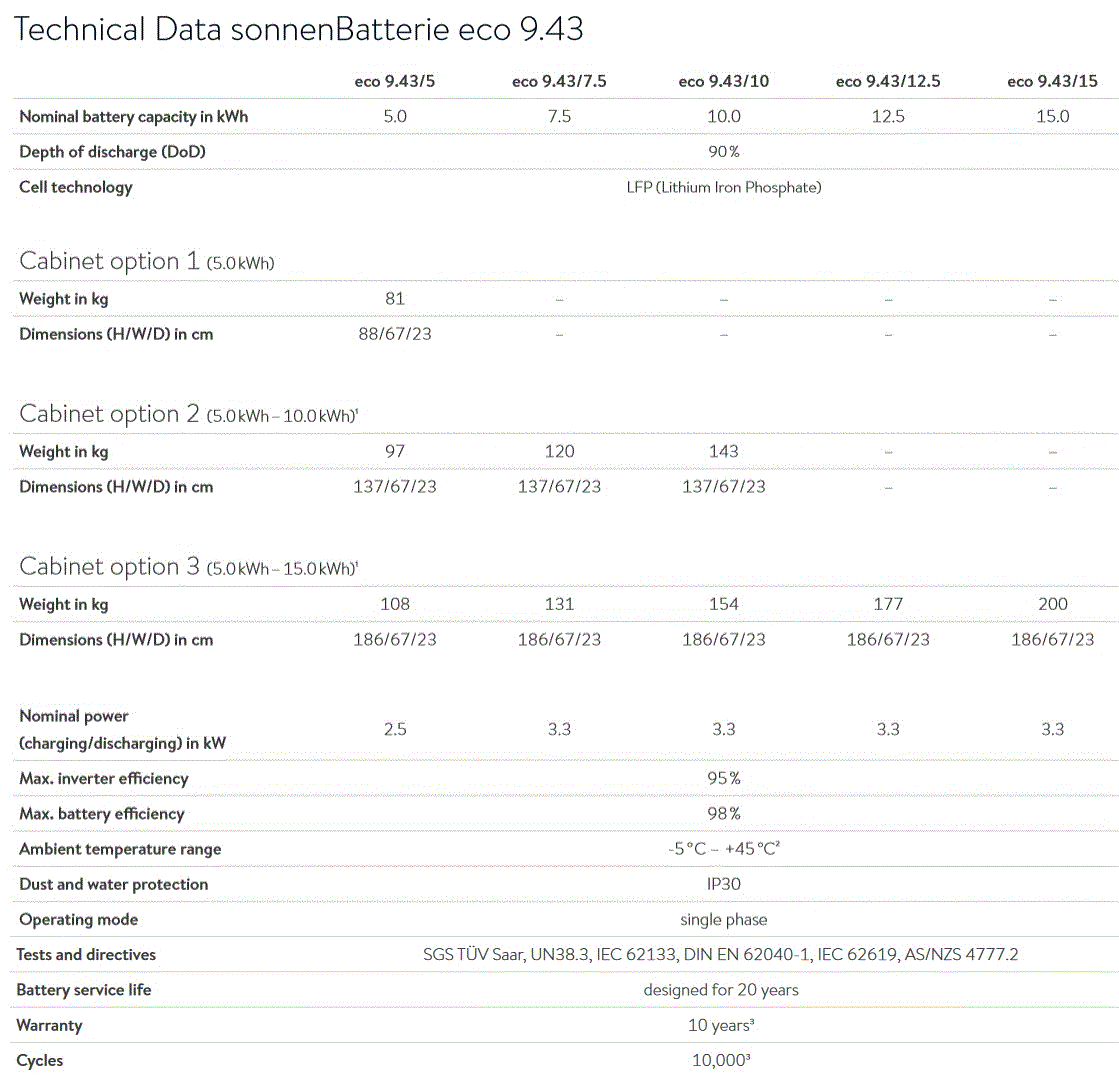
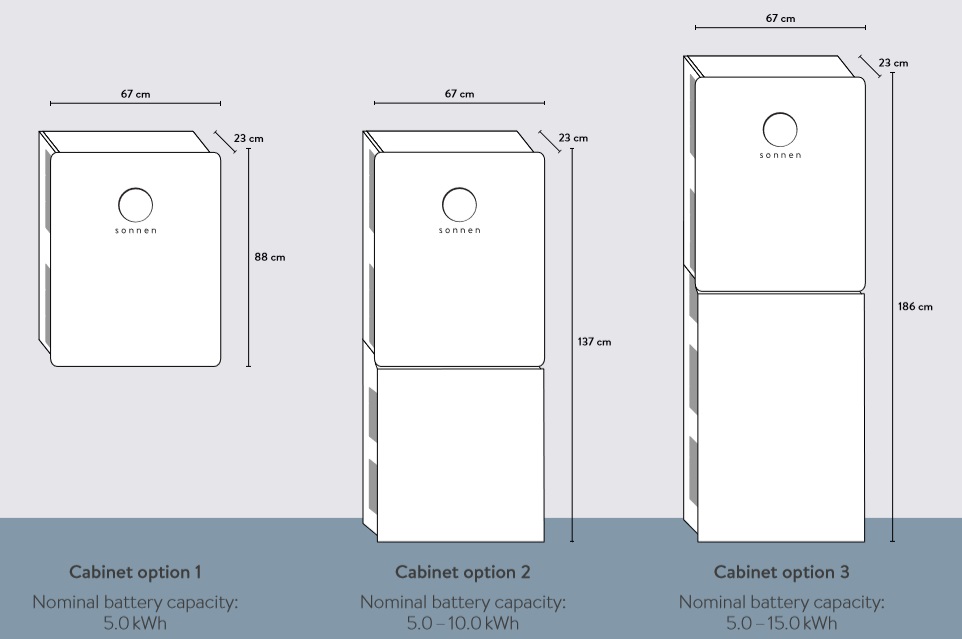
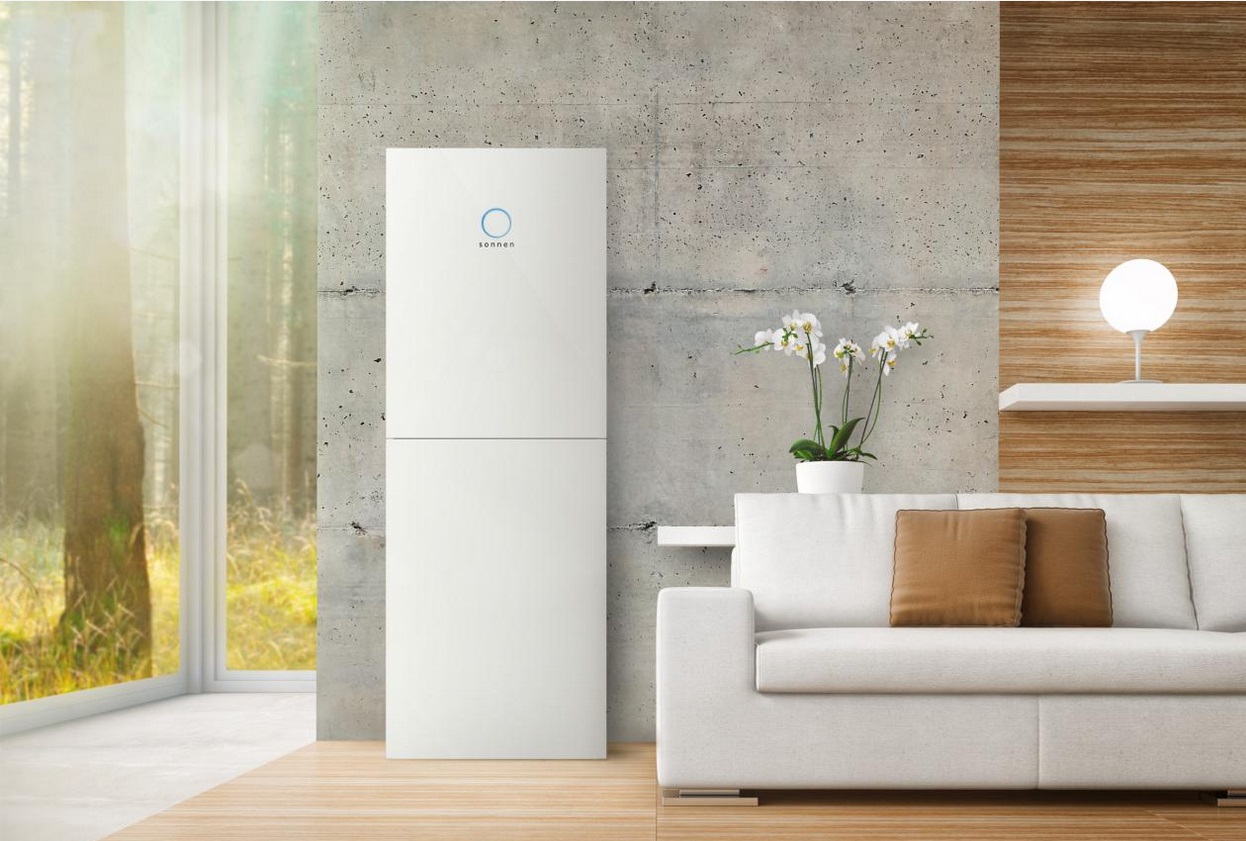
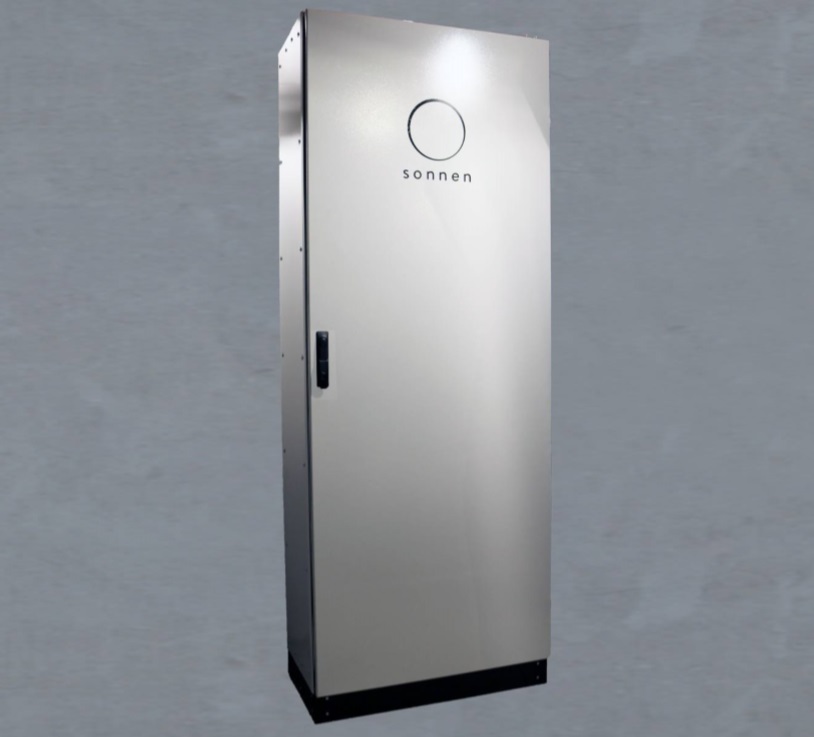
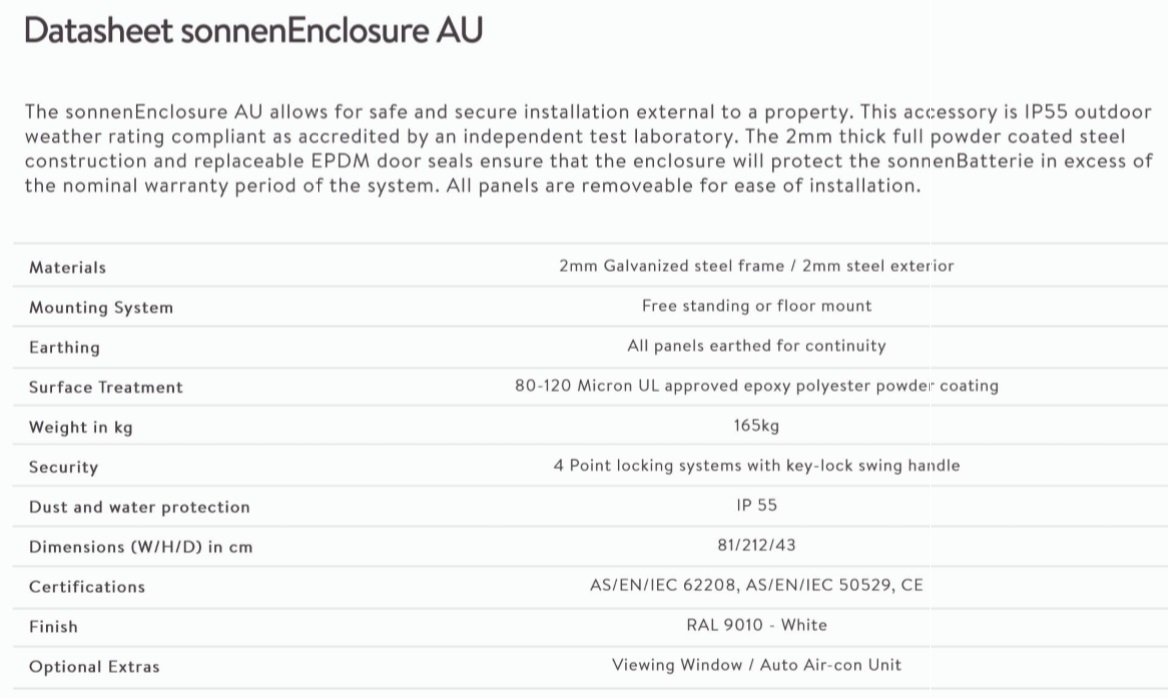
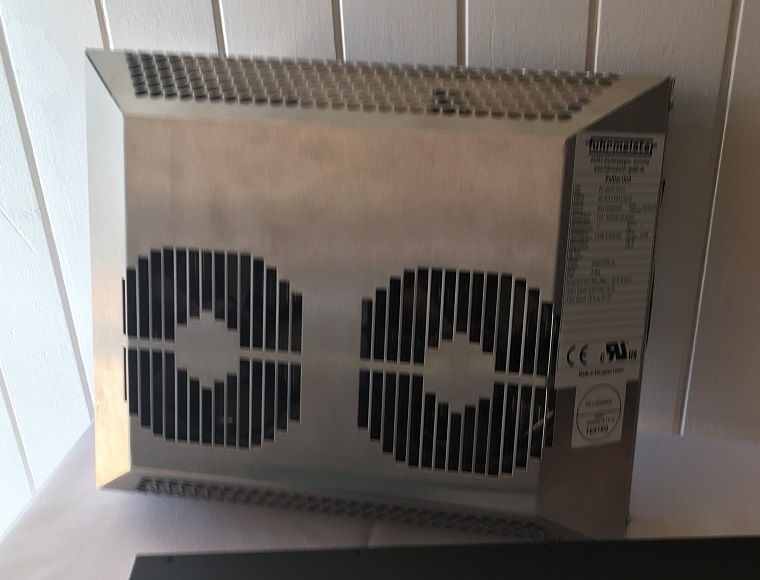
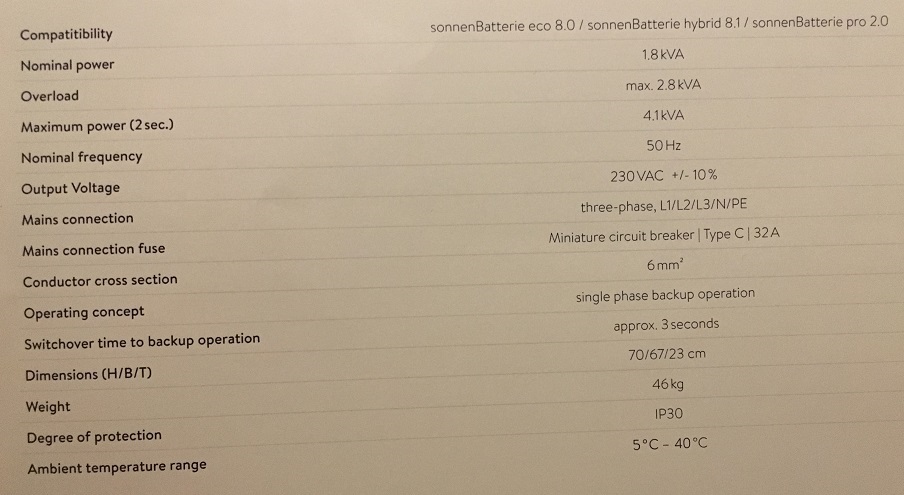
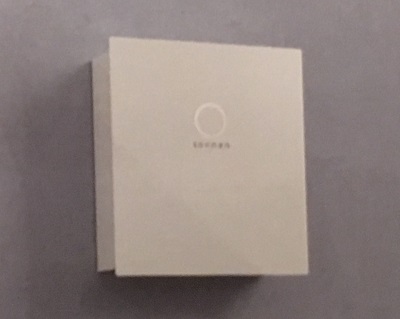
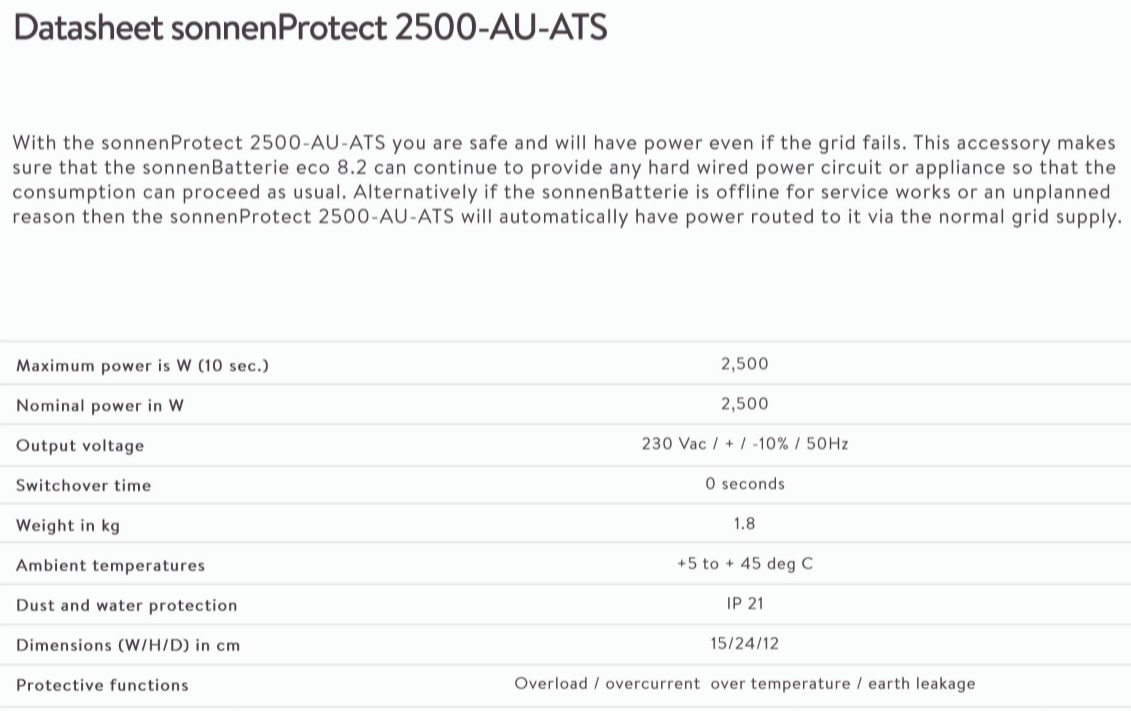
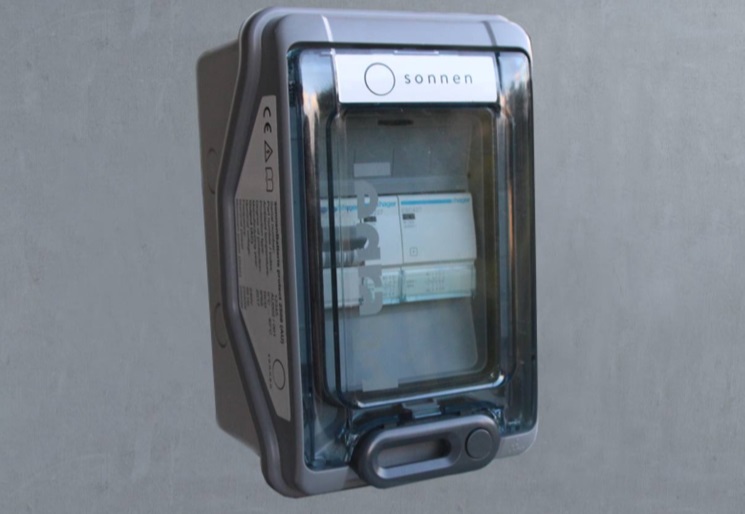


 RSS - Posts
RSS - Posts



Yes, I always love a good PR photo like the Sonnen battery inside photo…. Totally going against the CEC battery guidelines which state: Battery systems and pre-assembled BESS shall not be installed in the following:
• Habitable rooms, as defined by the National Construction Code (NCC)
I’m simply baffled that the Marshall Government have chosen to subsidise a range of energy storage products that include lithium when Australia has no documented Australian Standard for these batteries and their battery management systems.
What is also astounding to me is they have chosen to only make CEC approved solar retailers eligible to sell this product. Now please forgive my ignorance, but I’ve read the CEC solar retail code of conduct and it does not mention batteries anywhere….
Hanging out for Fridays industry update….
Dr Who is a she now…..
OK.. What have I got wrong?
According to Tesla’s AU website, one Powerwall (13.5 KWh) costs $9600. Meanwhile, sonnenBatteriegesellschaft is charging $16,500 for the same useable capacity. Looks like someone is driving around Munchen in a nice new Maybach company car.
I will not buy anything made in China if I can purchase similar products from any other country. The Chinese communist party (CCP) is an evil form of government and should not be supported.
Hi Ronald,
Great article and good information.
However, all your calculations are based in South Australia.
Here in N.S.W. we are forced to have smart meters when you install a solar system.
We get charged a time of use rate:
2pm-8pm about .62c per kwh
8pm-10pm shoulder rate, about .28c per kwh
10pm -7am off peak rate, about .15c per kwh
7am – 2pm should rate again.
So it’s a little harder to compare for N.S.W residents.
Furthermore, if you can manage your solar/battery system wisely, the pay off is a lot greater than South Australia. (faster pay off time).
As you probably already know, I get a credit on my electricity bill. As I make sure is have battery power when I need it (between 2pm and 8pm) where you get slugged the most.
On very overcast days, I will turn off my tesla battery (put on night mode) and as soon as it hits 2 pm, I will turn it on.
This formula has worked great for me.
This doesn’t happen very often as we get a fair bit of sun here in Sydney, but it’s another way/thought to fine tune an installation with batteries.
Hopefully they bring the battery subsidy to N.S.W. and really kick off battery installations.
Time of use is not mandatory in all NSW. I am in an Endeavour Energy area (Hawkesbury) and do not pay Time of Use (and never will voluntarily!). I do have a smart meter of course.
Griff is right – the good news – in most cases you can ring your energy supplier and even with a smart meter switch to single rate. The bad news – if you are a large off peak user (I am because of PHEV which I charge overnight) it works out almost exactly the same. I spreadsheeted a bunch of different energy companies based on my last bill and all their rates and confusing discounts and on that basis I can save a bit by switching to the basic rate with no discounts. But not a lot. And some of the solar plans with increased FiT may save more in summer. Waiting for a bill to examine that.
Using time of use tariff can be of advantage when used correctly with solar/battery power. Ever since I’ve had my batteries, I’ve never drawn from the street during peak rate times (even in continuous overcast weather, due to force charging my batteries at off peak rates), you would only force charge your batteries when you know of cloudy days are coming up. I have fine tuned my system to my advantage and I’m not worried about peak rates. If I didn’t have the large battery storage then i’d be looking for a different plan 100%.
First let me say I live in Mexico but many observations in your newletter apply to me. In talking about payback of any solar system the one thing not talked about much is this: Here in Mexico, where the power fails for no reason, blue sky, no wind, whatever, having backup is priceless. Can’t count the times I lost everything in the freezer and fridge because the grid went down for days, even weeks. So, unless you have lived in the dark for a couple weeks in a third world country forgive me for saying “there is more to solar and backup than just payback price”. Mike
Still hanging out for a good backup battery system that would remove the necessity for a generator. That way i could calculate the total expense minus a generator cost. Might help.
sonnentProtect is now 2.5kW according to Datasheet I received yesterday. Has AU on end of product code.
Interesting. It did seem under powered to me. The information I used was from a datasheet I Sonnen gave me here in Adelaide, but they may have decided to up its power output in the meantime.
I sent Finn a copy by email this arvo. Lots of changes. BTW installation can not assumed to be free. I believe it will be an absolute minimum of a grand and possibly (probably) more. 🙁
Thanks for that. And perhaps I should have made it clear I don’t expect it will be installed for free. I just wanted to show that even with optimistic assumptions it can’t be expected to save a typical household money over its warranty period.
I completely agree. The economics don’t stack up unlike a big PV installation. I tell my single phase supply customers who indicate the want a battery to either install an Enphase battery (they are mostly Enphase PV system customers) for the buzz or actually get a three phase supply so they can now or later go large. Many retailers will actually move house supply to three phase for a surprisingly low cost and the house can generally continue to operate (as before) on a single phase. And when they get their EV in a few years get more (cheaper solar) and they’re set 🙂
To be clear, I’m not a Tesla fan boy. But if the Powerwalll at $9600 is a marginal proposition, how can the Sonnen at$15.6K be even considered viable?
Forget about batteries for at least the next 5 years. As Ronald has said: it is not a paying proposition. The facts don’t stack up. I have 36 kWh lead gel batteries because I was denied grid access. So, I have my system separate from the grid, but can separately draw from the grid. The problem with the grid is the service charge which should be pro rate instate of a fixed tax irrespective or whether you use 10 kWh a quarter or 10,000 kWh.
Why forget about batteries????? read my post above. I have successfully got a great solar / battery system which will be paid off in 5.5 – 6 years time. (at current electricity prices, N.S.W. area). If you want details of my set up or fine details of bills etc. I will gladly share them with you or others, to prove to anyone that in N.S.W. it is a viable and worthwhile investment. Don’t get me wrong, I don’t throw my money away for no reason, (i’m 51 and I am self funded retiree), so I’m very careful with my investments, (hence why I’m retired).
Read my postings above.
In other states, it could be a different story, as the supply charges and kw ph rates are different, but in N.S.W. with smart meters (time of day use charges), it is very worthwhile investment.
I think this is wrong, If I use 9kw of batter after sunset that would have cost me $3.60 at 40c kwh, That is $3.60 x 365 days = $1314. After 10 years I have saved $13,140. Yest battery only cost me $7800 or $6800 as pensioner. Obviousness- at more than 40c kwh then the saving is higher
What have I missed?
Hi Rowan
If you had instead sent that electricity into the grid you would have received $1.47 in feed-in tariff with a 16.3 cent feed-in tariff and a 100% efficient battery. With a 90% efficient battery it would be $1.63. After discounts most people pay less than 40 cents per kilowatt-hour for grid electricity and it is very difficult for a normal home to use a battery at full capacity — that is always charge it to full with solar electricity during the day and always drain all usable stored energy overnight. There are likely to be cloudy or winter days when it can’t be fully charged and nights when less than 9 kilowatt-hours are used. Also, the capacity of the battery may decrease over time.
You have missed a lot. The calculations are not that simple. like I said before, our peak rates are .62c per kwh between 2-8 pm. I have 3 batteries totalling 23 kw which are hooked up to different phases of the house. The biggest battery to the biggest load (phase) then the other batteries to the other phases. We usually cycle our batteries to almost flat by the morning and by 10 am (Sydney, on a bright sunny day, Sept.-April) batteries are fully charged then the excess electricity is sold back to the grid for 12.5 c feedback rate. (last bill, 1,736 kw was sent back to the grid totalling $217.00 credit, 1/4 of the year). So as you can see, I have only scratched the surface of calculations and things to consider when making a decision of how big your solar system has to be, how big a battery storage has to be, (there is no use adding 30 kw of battery storage if you can only go through 10kw during the night) I have fined tuned my solar/battery/HWS to my household needs, every house is different, I don’t work as I mentioned before, I’m self funded retiree, there fore I turn on my HWS to heat up as soon as my batteries are full (around 10 am), about 11 am when the HWS is ready, most of the electricity produced after that is sent to the grid as buy back. Everyone needs to look at their own needs and usage patterns and fine tune them to your individual needs. There is not one system that will cater for everyone. The questions you need to be asked, do I have three phase or single phase?? what time do I/family members get home?? when is your bulk usage of electricity?? is your hws off peak, if so then you can run another wire to make it constant and switch it on during the day (sunny day) if there is going to be overcast days ahead, then turn it on to off peak till the weather clears up. which phase is your oven/cook top/ air conditioner/dryers/washing machine/fridge etc. on??? There is a lot to fine turning ones home. I’m at the point that I’m confident to say that my place, is, i’d say about 95% fine turned. So there no simple calculation here.
I know that my system is working great for me. I used to pay $1,050-1,250 per 1/4, now I get a credit of about $150 per1/4 during winter and about $250 per 1/4 in summer.
Wow Tim that is a huge system. How much did it cost if you don’t mind revealing, including install? And what kind of batteries are you using?
HI Tim, how can I contact you ? I am about to make a big investment in a 3 phase System for a family of 7 and I’m sure your wisdom and experience can save me a lot of time shopping around and working out which way to go with various aspects of the system. I think we would be looking at about 50KW battery capacity across the 3 phases. thank you.
How does adding a AC battery system to an existing Solar setup work in South Australia with the 5kW export limiting? A single phase 5-6kW Solar setup limited to 5kW export is probably fairly common in SA and I gather the current rules consider an AC battery in the export limit so it wouldn’t be allowed?
If you want to add an AC coupled battery and it would bring the total solar plus battery inverter capacity to over 5 kilowatts then the AC coupled battery will need to be capable of export limiting. As far as I am aware they are all capable of this.
There is a feature / setting in hybrid inverters that you or your installer can programme to only export 5 kw if that’s what your allowed.
I have a Tesla powerwall 2, it nearly always run flat (out of power) late at night. So it dawned on me that I should be “on a time of use” (alias off peak) plan. So the off peak rate starts at 10pm and finishes at 7am. The plan is about 14c a KWh.
So this should be used when calculating the pay off for the battery, not the peak rate.
Could I see calculations based on off peak rates as above?
Generally, if you have a battery you are better off on a time of use tariff. But South Australians should note they don’t have the type of time of use tariffs available in other states.
If you had solar before you got a battery and were better off on a time-of-use tariff then what you were paying on that before you got a battery is what you should compare your bill to now to see how much your battery saves you. But if you were better off on a standard tariff before you got a battery that is what you should compare what you are paying now to. Most — but not all — solar households are better off on a standard tariff if they don’t have a battery.
Correct, you should go on time of use rate. This way you have power from your powerwall 2 during the most expensive time 2-8 pm peak rate and 8-10 pm shoulder rate. Then when the battery gets flat, you will be drawing from the street at the off peak rate, so theoretically you should hardly ever pay peak rate. Another thing to consider is the weather. if you see that there will be rainy days ahead, you should force charge your battery during the night at off peak rate for use during the next day and evening. Charge at 14.5 c rate to use at on peak rate .62c. I’m not sure if pw2 has this feature as my pw1 doesn’t, for me to force charge the pw1, I have to ring SolarEdge and request this to be done for a particular night / s. This is very annoying. My lg batteries can be forced charged by simply programming the hybrid inverter. Another thing you could do to fine tune your installation, is, if you have a rainy day coming up, you could switch the pw2 to night mode after 10 pm to conserve it’s power for use during the next day, where your paying shoulder rate. So you see there is ways to minimise and turn things around to your advantage with a battery system. Another thing to consider is the hot water system. Are your on off peak?? if so, you could get your electrician to run another (constant) wire to the hws and turn it off at the fuse box, turn it on when your battery is charged, so this way your hws is being heated with solar only. Again if there is going to be bad weather ahead, flick it back to off peak, to be heating up during the night (normal). For this, you will need a separate switch on or near the hws, so you can switch back and forth from the off peak wire to the constant wire. (This is how my system is).
Great conversations going on here. As I live in Mexico many of the threads do not apply to me (metering changes based on time of day). One thing I also have here is a solar hot water heater, which are becoming very popular here. As a gas or electric water heater run often day or night to maintain hot water when needed, they are costly. A solar hot water heater has an insulated tank that maintains very hot water day and night. Mine has the capacity of three showers at night during cold weather. As my old bones love a good long hot shower I love and appreciate “free” hot water. I calculate that the price of the heater, plus install (included in price) paid for itself in one year. That was three years ago and we never looked back, great investment.
I am not pleased with the situation that has occurred to us. We installed a 9.9kw system last December and have had it functioning well till this August when our next door neighbor installed a 30kw 3 phase solar system. Since then from 10.3 0am till sundown our system keeps dropping out, only to start again, then drop out. A voltage check shows our line voltage is 262v. SA Power networks know about he problem, but we are still awaiting some assistance, note that us and the neighbor are the only consumers on the power line.My concern is that that constant shutting down and restarting will damage our equipment.
Any comments.
It sound like to me that the lines (street) are being overloaded and in turn pushing your neighbours excess electricity production into your inverter which cuts out to protect itself. Look into some sort of devise or transformer to minimise any electricity spikes. I don’t even know if these exists, but i’m certain a good electrician should have an answer. I’d imagine that this device should go to the power “IN’ on your inverter to limit it to 240 -250v NOT 262v. The inverter is doing what it’s supposed to do, to protect itself. But your right, eventually, the invert will have a much shorter life span.
In reply to the comment from Tim Efthymiou, that is good advice.
My hot water system is gas anyway.
I did not make it clear in my original post concerning the calculations over the pay off for batteries. This is the point I should have made – If I did not have a battery then I would likely be on the regular plan and pay the same rate regardless of time of day, around 28c per KWh, but having the battery means that I can go on time of use and pay about 14c per KWh.
So I am not only saving the electricity that the battery can store and use after sun down, but when I do use the grid I am paying off peak rates.
Good advice about charging the battery on off peak rates, I can easily set the Tesla PW2 to back up mode when it is fully charged in the evening, then change it back the next day when it is raining, it is suppose to rain hard tomorrow here so I will try it tonight.
Niels – it’s the battery chemistry. LiFePO4 is typically a LOT more expensive than LiMn or whatever battery chemistry Tesla is currently using. It also lasts a lot more cycles – particularly when provided in such a limited setup as the Sonnen. I note the maximum the warrant on any system is a paltry 0.6C on batteries that can typically deliver 5C continuous and safely. The 15kW system doesn’t make a lot of sense because it can only deliver as much as the 6kW system, (3.3kW cont). If sonnen included a better inverter as they go up in capacity they could theoretically deliver much higher – around 9kW continuous.
To actually determine if the sonnen has a better lifecycle you have to subject a sonnen and a PW2 to exactly the same test cycle (charge and discharge) over at least the 10,000 warranted cycles to get an accurate result.
Hi Mondo
Sonnen says they will be producing a 3 phase battery system for Australia that can provide considerably more power, but it’s still in testing to ensure it can handle Australian conditions and I don’t have information on it yet.
Great – still don’t understand why they didn’t go for a higher capacity inverter with their larger batteries though? If their 6kWh batt can handle 3.3kW continuous then logically the 15kWh should be able to deliver 8.25kW continuous. Sure an inverterthat big might be too expensive but plenty around the 6kW mark. That would be a real point of difference with the PW2.
Well the prices are in after the battery subsidy and they are WAY more expensive than the estimates that Ronald made. Not his fault; he just went off the existing prices and applied the subsidy.
I am just trying tio get a price on a sonnen battery with out all the government rebates. Just want a straight answere , cost to install not thousands of dollars on top it seems a very simple connection
HI Ronald
I have three phase power to my house and have two 5kw solar panel strings on two of the three phases each with their own single phase SMA inverter.
A sales rep tells me that the Sonnen single phase battery with the Sonnen Protect 2500 has the ability to send power to all three phases even in times of black out. Do you agree with what they are saying?
It operates at an air temperature of up to 45 degrees, In Queensland we get temperatures well over this , will that kiss the warranty good by
Hi Tim
I think it is about time you explored the faulty SA Power grid system in SA. We have a 10kw system installed last December, it performed fairly well about 60% until our neighbor installed a 20kw 3 phase system in August. From then on our system continually dropped out, after our solar installer was contacted many times he came and installed a smart meter and set the voltage at 258V.
The system still kept dropping out and on a clear day is only producing about 16kw. 1.6% efficient, this means that we will be getting a bill. SA Power came and fitted a Logger for a week, when they came to remove it they said it was all our fault for trying to put supply on the line that didn’t need it, due to the neighbor fully charging the three phases. We and the neighbor are the only consumers on what is a bundled cable supply from the city edge. They also said that they were not required to accept power into their system, even though they had granted permission to install it. Their only response was buy a battery. !!
So much for proper planning of our national grid.
What to do, being an 82 year old pensioner trying to provide for our independence now with a worthless installation.?
Keith – SA Power Networks have a legal obligation to keep your local grid within certain voltage limits.
If they are blaming your installation for the voltage rise – then you need to:
1) Prove that it is not your system causing the problem
2) Prove that it is the grid causing the problem.
Then present the evidence to SAPN and do not rest until they fix your grid.
Here’s a step-by-step guide to doing this (you’ll need a sparky to do the tests):
https://support.solarquotes.com.au/hc/en-us/articles/115001759153-My-Inverter-Keeps-Tripping-or-Reducing-Power-On-Over-voltage-What-can-I-do-
Had the same problem in Brisbane , Grid over Voltage would go up to 297volts, it was not to go over 255-260volts and was shutting down the smart inverter about 6 times a day , The inverter was sending me e-mails in LX format showing when it shut downs and started up. We were losing 3 hours a day some days, talked to an engineer at our supplier , but did no good ,got hold of the public relations department of our electric supplier told them must be mad as they were losing money and I had a 20 page xl spread sheet saying so , and how Energex was breaking the law by not complying with AS4777 ! They had an Energex engineer and electrician out the next week to alter the settings of the inverter and our bill dropped by $300
There is a conflict of interest in the electricity wholesalers – they do not look after the consumer, despite what they state on their websites. Increased line voltage is a way they can “bleed” excess power being produced, but it also means that the consumer is paying more as that power has to be paid for. Solar installations on roof tops are often blamed as the cause of this, although at night, the voltage on the lines is almost always greater than the nominal 240volt. Power companies do have an option to fit voltage regulators on their transformers, but this costs money, so they don’t. Until there is a way to use the excess power being produced (generally in the middle of the day), I cannot see any australia wide improvement. But, there are a lot of solar farms being proposed and built, and surely this will just add to the problem of excess power during the day. Time for a royal commission..
Having studied the sonnen situation in Europe, it seems like sonnen has set its focus on becoming a power supplier in the future. With their so called Sonnen Community they create a network in which a lot of energy can be stored. With the foreseen closing of nuclear powerplants in Germany and the reduction of coal operated powerplants before 2025 due to climate goals, controlling a substantial part of the energy supply could be a profitable businessmodel. Certainly when you consider that sonnen itself doesn’t invest in this network but its customers do. Since the batteries are connected (and controlled) via internet sonnen can manage all batteries. customers do not have access to the batteriesoftware as far as I know at the moment.
Where the taxpayer paid for the old fashioned state owned grid, got confronted with rising costs of energy after privatizing, it seems to me that someone found a smart trick to fool a lot of solar energy fans.
I have a 10.03kW system which throttles approximately 130 kWh per month [loss of potential production] due to the maximum of 5kW we can export in the moment. The loss of opportunity cost based on throttling without storage is 0.09c per kWh 130 x 12 x .09 = $140.40 pa, It has quite a different value if the loss of potential production is generated and sent to storage. Our current round trip is 85% 130 x .85 = 110 kWh. Our General Tariff is 0.28c minus FIT 0.09 = 0.19c per kWh. That being the case you can add to the battery savings 110kWh x 12 mths x 0.19c = $250.80 by eliminating the loss of potential production.
I think that’s an interesting edge case for battery storage but it may be cheaper to connect three phase and not be throttled? I’m not sure if that’s economically feasible in your situation.
The Sonnen specs say “forced air”… how many fans are inside the Sonnen eco products? Is it “active cooling”? The backup box appears to show what would look like 2 large fans, is that right?
I am just trying tio get a price on a sonnen battery with out all the government rebates. Just want a straight answere , cost to install not thousands of dollars on top it seems a very simple connection
I don’t think this article is correct.
I installed a 10.5kWh Pv system which was quoted by a solarqoutes installer.
Several weeks later I bit the bullet and installed a 16kWh sonnenBatterie.
since then we have not drawn a single watt from the grid and we are pumping power back with a feed in of 22c per kWh
Even with all the smoke the battery is fully charged by 2 or 3 pm.
My calcs say the complete system will pay back in just over 7 years, and I expect 15 years from the battery based upon user reviews.
I looked at sonnen flat but that means I dont get paid for grid feed in so doesnt work even though they are offering 2 years free at the moment.
This article seems to be taking the piss out of a teriffic product, not something I expected to read on an otherwise helpful website.
Hi Graham
Glad to hear your Sonnen battery is working well for you. It’s also good to hear the payback time for both the solar and battery will be just over 7 years. Unfortunately, it’s not possible to see the financial benefit from the battery alone when the payback is combined like this. If you are able to calculate the payback time of just the battery and find it’s able to pay for itself within its warranty period or even close to it, let me know as I would like to write an article about on it. There’s a real lack of information on how well different battery systems perform under real world conditions.
Ron,
I don’t understand your insistence on calculating the payback time of a battery alone. You would never install it alone. Might as well ask what is the payback time of a solar array without an inverter. If the system as a whole has a payback of 7 years that is the most important information.
And by the way regarding your father and his power usage; Australians per capita use over 50% more electricity, use 20% more power of all types, than the Dutch (see here:https://en.wikipedia.org/wiki/List_of_countries_by_electricity_consumption) So your father probably learned his profligate energy ways here. The Dutch have a similar population to Australia and similar average incomes and produce less polution and have a 12% higher GDP per capita. Perhaps we should stop being so ignorant and try to learn from them. Their recycling systems also make us look like the incredibly primitive polluters we are.
By the way I am not Dutch but have visted there many times and married one.
For people who want to get a battery to save money it’s important to allow them to see if it’s worth getting. If a $10,000 battery system will only save them an estimated $11,000 over 10 years they may decide they would be better off just getting solar and putting the money saved towards their mortgage.